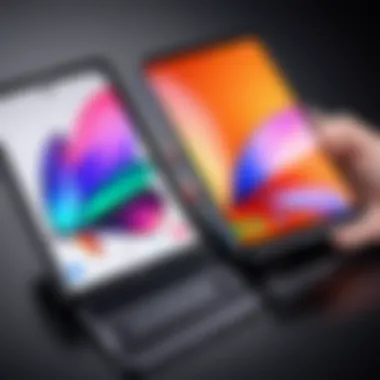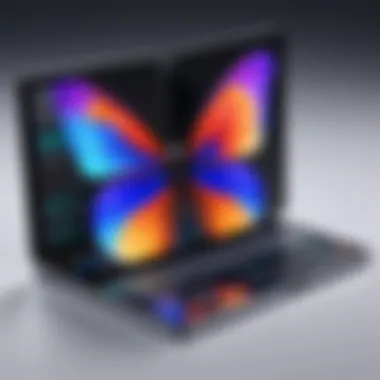Samsung Z Fold 3 Resolution: In-Depth Analysis and Insights


Intro
The Samsung Z Fold 3 is a remarkable device that pushes the boundaries of mobile technology. Its unique folding design and high-resolution display make it a standout in the smartphone market. As technology evolves, understanding the specifications and features of devices becomes crucial, especially for IT professionals and tech enthusiasts. This analysis will provide a thorough examination of the Z Fold 3’s resolution and how it affects user experience and productivity.
Performance Metrics
Benchmarking Results
Performance metrics are essential to evaluate the capabilities of any device. The Samsung Z Fold 3 incorporates a dynamic AMOLED display that measures 7.6 inches when opened and offers a resolution of 2208 x 1768 pixels. This ensures sharp, vibrant visuals. In benchmarking tests, the Z Fold 3 consistently showcases high performance, often achieving scores that place it among the best in its class. Key performance metrics for the Z Fold 3 include:
- High refresh rate of 120 Hz
- Brightness levels reaching up to 1200 nits
- Excellent color accuracy
These metrics contribute significantly to a seamless user experience, especially during demanding tasks such as multitasking and gaming, which are common in the professional realm.
Speed and Responsiveness
Another important aspect of performance is speed. The Z Fold 3 runs on a Snapdragon 888 processor, paired with up to 12 GB of RAM. These specifications ensure that the device manages tasks with remarkable efficiency. Users will notice:
- Quick app launches
- Smooth transitions between applications
- Minimal lag during multitasking
These characteristics help maintain productivity, making the Z Fold 3 a suitable option for professionals who rely on speed and responsiveness in their daily tasks.
Usability and User Experience
Ease of Installation and Setup
When a new device is introduced, its installation process plays an important role. The Z Fold 3 simplifies setup with a user-friendly interface. Upon turning on, users are guided through initial configurations, which include
- Connecting to Wi-Fi
- Transferring data from old devices
- Setting up security measures
These steps are quick, allowing users to navigate the device swiftly. This ease of installation can save valuable time in professional settings.
Interface Design and Navigation
The Z Fold 3’s interface is tailored for large displays. Samsung's One UI is specifically developed for flexible user experiences. It allows for:
- Split-screen multitasking
- Adaptive app interface
- Comfortable access to notifications and apps
The design leverages the device’s unique features to enhance usability. Users can operate multiple applications seamlessly, which is crucial for those who handle various tasks concurrently.
"With its intuitive interface and excellent navigation, the Samsung Z Fold 3 fosters an environment conducive to productivity."
Closure
In this analysis, we have illuminated the extensive capabilities of the Samsung Z Fold 3's resolution. From performance metrics to usability, it is evident that the device is engineered with the needs of IT professionals and tech enthusiasts in mind. With strong benchmarking results and a design that promotes efficiency, the Z Fold 3 stands as a testament to advanced mobile technology.
Foreword to Samsung Z Fold


The Samsung Z Fold 3 represents a significant leap in foldable smartphone technology. It combines innovation and practicality in a way that addresses many challenges faced by prior models and the traditional smartphone design. The importance of this device cannot be underestimated, particularly for professionals in information technology and tech enthusiasts. Understanding the nuances of the Z Fold 3, especially its resolution capabilities, is essential for anyone leveraging mobile technology for productivity and usability.
The Z Fold 3's unique design facilitates a multi-tasking approach, which is increasingly valuable in professional settings. The device's capability to transform from a phone to a tablet provides flexibility that is not only practical but also enhances user experience. With this adaptability, it suits the needs of various users, such as developers, designers, and business executives, who often rely on multiple applications simultaneously.
Furthermore, resolution plays a key role in how content is displayed and interacted within this foldable structure. Higher resolutions can vastly improve visual quality, making it easier to work with detailed documents or intricate designs. This article will delve into different aspects surrounding the Z Fold 3, shedding light on how its resolution enhances overall functionality.
Historical Context of Foldable Phones
The evolution of foldable phones has been a fascinating journey. Early attempts at flexible displays began with basic prototypes, but the technology did not mature until the last decade. Companies started to realize that foldable designs could combine portability with usability, creating a device that addresses the growing need for screen real estate without sacrificing compactness.
Samsung emerged as a pioneer in this field, gradually developing its foldable technology through continuous iterations. The Galaxy Fold, released in 2019, marked a significant milestone, though it faced criticism regarding durability and usability. These insights paved the way for advancements in future models.
Overview of Samsung's Foldable Series
Samsung's foldable phone series has steadily evolved since its inception. Starting with the Galaxy Fold, the company refined its designs and technology in subsequent models, including the Galaxy Z Flip and the Z Fold 2. Each model brought improvements in durability, software optimization, and overall functionality.
The Z Fold 3 builds upon this legacy, introducing enhancements like S Pen support and improved hinge mechanics. Its specifications cater to both casual users and professionals looking for advanced capabilities. A focus on resolution and display quality has been central to Samsung's design philosophy, cementing its reputation as a leader in the foldable smartphone market.
Technical Specifications of Samsung Z Fold
The Samsung Z Fold 3 marks a significant evolution in the line of foldable smartphones. Understanding its technical specifications provides essential insight into how this device enhances user experience and productivity, particularly for IT professionals and tech enthusiasts. The emphasis on specifications reveals not just numbers but the underlying technology that drives the performance and usability of the Z Fold 3. This section covers multiple aspects including display dimensions, resolution, and the types of panels utilized in this innovative device.
Display Dimensions and Aspect Ratios
The display of the Samsung Z Fold 3 is one of its most appealing features. With an unfolded size of 7.6 inches and a resolution of 2208 x 1768 pixels, the main screen is a visual canvas. When folded, the cover display spans 6.2 inches with a resolution of 2260 x 832 pixels. This contrast in size plays a crucial role in how users interact with the device.
The aspect ratios further illustrate the design intentions. The main display has an aspect ratio of 22.5:18, while the cover display adopts an 24.5:9 ratio. Such configurations enable applications to utilize screen space effectively, ideal for multitasking scenarios. Users can comfortably view two applications side by side, which is increasingly relevant in professional settings.
Resolution Details
Resolution stands as a key determinant of visual quality in modern devices. The Z Fold 3 features Dynamic AMOLED 2X technology that promises vibrant colors and deep blacks alongside its impressive resolution. Beyond mere pixel counts, this technology enhances the viewing experience with support for HDR10+ content, amplifying the brightness and contrast of media.
As for pixel density, the main display reaches approximately 374 pixels per inch (PPI) on the larger screen, while the cover display provides a density of 393 PPI. Higher pixel density translates to sharper images and more precise text rendering, which can significantly impact tasks such as reading or data analysis for professionals who rely on their devices for productivity.
Panel Types and Technologies Used
Samsung has integrated advanced technologies in the Z Fold 3 to optimize performance and durability. The primary display utilizes the proprietary Dynamic AMOLED 2X panel, known for its excellent color accuracy and refresh rates. With a refresh rate of up to 120Hz, users experience smoother scrolling and interactions, particularly noticeable in applications like games and video playback.
Moreover, the panel's construction incorporates Gorilla Glass Victus, providing improved scratch resistance and protection from falls. This feature is especially beneficial for professionals who frequently use their devices in varying environments.
In addition to visuals, the Z Fold 3 supports S Pen functionality, a breakthrough in usability for creative and professional tasks. This capability broadens the device's potential, allowing users to annotate documents or create drawings with precision.
"The combination of resolution, technology, and material design in the Samsung Z Fold 3 exemplifies a commitment to enhancing user engagement and productivity for both casual users and professionals."
In summary, the technical specifications of the Samsung Z Fold 3 are crucial for understanding how this device differentiates itself in the competitive smartphone market. The interplay of display dimensions, resolution, and advanced technologies coalesce to establish a product that serves various needs in the context of modern mobile usage.
Understanding Resolution in Mobile Devices
Resolution plays a critical role in mobile devices, serving as a fundamental aspect that dictates the visual experience of users. In the context of the Samsung Z Fold 3, understanding resolution becomes vital for several reasons. Firstly, higher resolution screens can display more detailed images and text, enhancing clarity and overall aesthetics, which is particularly crucial for professional use. Secondly, as devices evolve, users expect greater immersive experiences, compelling manufacturers to focus on improving resolutions. This section dives into defining screen resolution, its impact on visual quality, and how users perceive this metric.


Defining Screen Resolution
Screen resolution refers to the number of distinct pixels that can be displayed on a screen, usually denoted in width by height—for instance, the Z Fold 3 boasts a resolution of 2208 x 1768 pixels for its main display. Each pixel is a unit of measurement that contributes to the overall image clarity and detail.
A crucial element of resolution is its relation to pixel density, measured in pixels per inch (PPI). The Samsung Z Fold 3 achieves an impressive pixel density, making text and images sharp. When users observe screens with higher resolutions, they notice that detailed content such as documents or photos appear smoother, reducing strain on the eyes during extended use.
Impact on Visual Quality
Visual quality encompasses more than just resolution. However, resolution is one of its primary architects. When screens have higher resolution, images turn out sharper and colors appear more vibrant. The Z Fold 3 employs Dynamic AMOLED 2X technology, which enhances color accuracy and brightness while reducing power consumption.
The benefits of higher resolution in everyday applications are notable. Users can engage with multimedia content like videos and games with better definitions. For professionals, high resolution means less scrolling and zooming, creating a more comfortable workflow and boosting productivity. The overall experience becomes not just functional but also aesthetically appealing, affirming the importance of resolution in modern mobile technology.
User Perception of Resolution
User perception of resolution is subjective and can vary based on individual experiences and expectations. Generally, most users associate higher resolution with better quality, where crisp images and clear text lead to more satisfactory experiences. Furthermore, as users interact with numerous devices across different contexts, they begin to form standards for what constitutes an acceptable resolution.
Research indicates that when faced with lower resolutions, users often express dissatisfaction, particularly when using the device for professional tasks. In contrast, the Samsung Z Fold 3’s resolution caters to these high expectations, making it a preferable choice among technology enthusiasts and IT professionals alike.
"Resolution is not just a number; it shapes the experiences and perceptions of millions of users engaging with technology daily."
In summary, understanding resolution in mobile devices is not an isolated concept. It intertwines with the technology employed, user satisfaction, and the evolution of device capabilities. As mobile devices continue to integrate advanced features, resolution will remain a pivotal factor in dictating the quality of user experiences.
Z Fold 's Resolution Performance
The resolution performance of the Samsung Z Fold 3 holds significant relevance in understanding how this device functions in practical use. Resolution affects not just the clarity of images, but also the overall user experience. Here, we delve into three important aspects: comparative analysis with previous models, real-world applications, and experiences in gaming and multimedia.
Comparative Analysis with Previous Models
When evaluating the Samsung Z Fold 3, it is critical to look at how it compares with its predecessors. The Z Fold 2 was notable for its 120 Hz refresh rate and a large 7.6-inch primary display. However, the Z Fold 3 improves upon this, as it maintains the same size but enhances the durability and performance. The screen resolution remains at 2208 x 1768, similar to the Z Fold 2. Yet, the new device introduces Gorilla Glass Victus, providing better protection against scratches and drops while enhancing color vibrancy.
Importantly, the Z Fold 3 supports the S Pen, which was absent in earlier foldable models. This addition enhances the device’s utility for professionals, offering precision and control. Users might note that when engaging in multitasking, the improved software support further enhances visual clarity, making simultaneous applications more user-friendly.
Real-world Applications of Resolution
In practical scenarios, the Z Fold 3's resolution contributes to its functionality in diverse activities. Professionals often use the device for multitasking, requiring seamless transitions between applications. The resolution ensures that split-screen views, document editing, or video conferencing remain clear and crisp. The 120 Hz refresh rate enhances these aspects, making interactions feel smooth.
Additionally, for IT professionals, the Z Fold 3's high resolution enables accurate data visualization. Graphs, charts, and complex visual data can be displayed without losing crucial detail. Furthermore, the immersive screen facilitates training sessions, allowing for effective presentations and enhanced user engagement.
Gaming and Multimedia Experiences
The gaming capabilities on the Samsung Z Fold 3 are noteworthy. With its large display and vibrant resolution, the device provides an impressive gaming experience. Titles that traditionally rely on high resolution, such as "Call of Duty Mobile" or "Genshin Impact," thrive on this platform. The display not only captures the nuances in graphics but also benefits from the faster refresh rates, contributing to more responsive gameplay.
When it comes to multimedia consumption, the resolution excels in delivering high-definition content. Streaming services like Netflix utilize the device’s capabilities, providing sharp images and vibrant colors. The cinematic experience is augmented by the stereo speakers, making it an attractive option for users who appreciate film and media.
"The Samsung Z Fold 3 is not just about aesthetics; its resolution performance significantly elevates productivity and entertainment for users."
Usability Aspects of the Z Fold
The concept of usability is crucial when assessing the impact of a device like the Samsung Z Fold 3. This device merges advanced technology with practical application, aimed at enhancing user experience. Usability encompasses various elements, which include multitasking capabilities, user interface design, and the adaptability of the device in professional settings. These aspects not only influence daily activities but also determine how effectively this device can be utilized in different environments.
Multitasking and User Interface


The Samsung Z Fold 3 is designed with multitasking in mind. Its large, foldable display allows users to open multiple applications side by side. This is especially useful in professional contexts, where accessing information from different sources simultaneously can improve efficiency. For example, an IT professional might use a coding platform, documentation, and a web browser all at once.
The device’s user interface is optimized for this feature. Enhanced by Samsung's One UI, it supports drag-and-drop functionality, allowing for smoother transitions between tasks. Features like the taskbar enable users to easily switch between apps without losing context. However, this may also require some adjustment from users who are accustomed to traditional smartphone layouts.
Challenges in Daily Usage
Despite its strengths, the Z Fold 3 is not without challenges in everyday use. The foldable screen, while innovative, poses its own set of concerns. For instance, the crease in the middle of the display can be distracting for some users. The aspect ratio can also affect how applications are displayed. Not all apps are fully optimized for this unique format, leading to varying experiences.
Additionally, durability concerns come into play with foldable technology. While the Z Fold 3 utilizes Gorilla Glass Victus and an Armor Aluminum frame, heavy daily use could still impact its longevity. Users must be aware of how they handle and care for the device to mitigate potential issues.
Adjustments for Professional Settings
In a professional environment, the Samsung Z Fold 3 introduces new workflows. IT professionals may find the adaptability of this device advantageous, particularly in meetings or collaborative settings. The ability to share screens or use the device as a makeshift tablet can facilitate presentations.
However, professionals need to adjust their habits to maximize its potential. Customizing settings to suit specific tasks may improve overall efficiency. The flexibility of the Z Fold 3 allows it to fit into various roles but also demands that users rethink traditional workflows. They may need to experiment with different applications to find the best combinations that suit their needs.
Future Implications of Technology like Z Fold
The Samsung Z Fold 3 represents a significant turning point in the evolution of mobile technology. Its resolution and display features are not merely enhancements for consumer enjoyment; they signal broader changes on how we think about our devices. Understanding these implications is crucial for IT professionals and tech enthusiasts alike.
Trends in Device Design and Functionality
As we look at the Z Fold 3, one can't help but notice the paradigm shift in device design. Manufacturers are increasingly prioritizing versatility and functionality. Foldable phones like the Z Fold 3 integrate larger screens into a compact form factor, optimizing space and usability.
- Increased Screen Real Estate: Users gain more screen space without enlarging the device itself. This addresses the common need for larger displays in both professional and personal use.
- Enhanced Multitasking Capabilities: The ability to run multiple apps side by side is becoming standard. With the Z Fold 3, users can engage in more productive workflows, toggling between documents and communications seamlessly.
- Innovative User Interfaces: Samsung has created unique software adaptations for foldable screens. This translates complex tasks into simpler interfaces. It will likely inspire others to adopt similar methodologies.
These trends are reshaping the expectations of what mobile devices can achieve. The future will likely see an influx of products that prioritize flexibility and user adaptability.
Potential Impact on Workflows in IT
In the realm of IT, the Z Fold 3 has the potential to redefine workflows significantly. It's not just about the device itself; it's about the systems and processes that revolve around such technology.
- Collaboration Efficiency: The device encourages fluidity in group work. Its large display allows teams to collaborate on digital projects effectively, reducing the friction of passing around smaller screens.
- Data Handling and Processing: With the powerful processing capabilities of the Z Fold 3, IT professionals can manage data-heavy applications more efficiently. This is vital for tasks that require immediate analysis and response.
- Adapting to Remote Work: As remote work becomes more common, devices like the Z Fold 3 support professionals in staying productive regardless of location. Employees can manage their tasks without being tethered to a desktop.
"The evolution of mobile technology exemplified by the Z Fold 3 will likely inspire the next generation of productivity tools, allowing for seamless functionality in all aspects of work."
Ending and Recommendations
The discussion around the Samsung Z Fold 3’s resolution holds significant relevance for its users, particularly for those in the information technology realm. The understanding of display resolution and its effects is crucial for optimizing user experience and operational efficiency. By taking into account aspects such as screen vibrancy, clarity, and responsiveness, IT professionals can better leverage the capabilities of this device in professional environments.
Through this analysis, several key elements emerge as beneficial considerations. First, the impressive resolution of the Z Fold 3 directly relates to enhanced visual quality. This attention to detail in display technology ensures that tasks requiring precision and clarity, like graphic design or data visualization, can be executed effectively. Additionally, the Z Fold 3’s resolution supports a multitasking approach, enabling users to work efficiently across apps without significant degradation in image quality.
Another consideration is how the resolution impacts overall productivity. IT professionals can benefit from high-resolution screens when it comes to extended work sessions. A clearer display reduces eye strain and allows for prolonged engagement with content. This enhancement is paramount in scenarios that involve reporting, coding, or any task that may require long periods of screen time.
Finally, understanding the specific technical aspects of the device, such as its dynamic refresh rate and adaptive brightness, can lead to better decision-making when it comes to device usage in varying environments. Engaging with these specifications allows IT professionals to implement strategies that make the most of the device’s capabilities.
Summary of Key Findings
The analysis delineates several findings:
- The Samsung Z Fold 3 features a high resolution, ensuring vivid and detailed images.
- Its display technology supports better multitasking with smoother transitions across applications.
- Increased resolution directly correlates with reduced eye strain, thus improving user comfort during extensive use.
- Knowledge of display features allows users to better tailor their environment for productivity gains.
Final Thoughts for IT Professionals
In closing, the Samsung Z Fold 3 emerges as an important contender in the foldable device market, particularly due to its resolution and display specifications. For IT professionals, these facets provide significant advantages in productivity and user comfort. Adapting to the features of the Z Fold 3 can ultimately transform daily workflows. By recognizing the strengths of this device, professionals can harness its capabilities effectively, ensuring that their tech environment is both productive and accommodating. The Z Fold 3 is more than just a device; it is a tool that holds the potential for enhancing how work is approached in the digital age.



